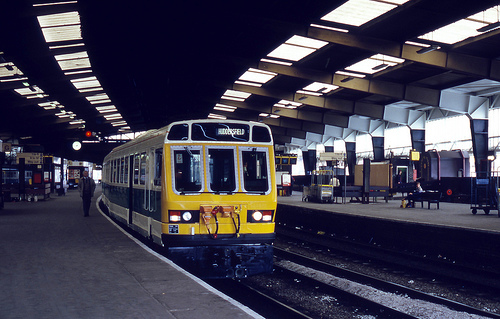


See when virtually brand new at Leeds Station on May 11th 1984 the set was then painted in ‘Verona Green and Cream’, the colours of the West Yorkshire Passenger Transport Executive. Photo By Keith Long
This is the newest item (age wise) in the Llangollen Railcars collection and represents one of the first attempts to provide a cost-effective replacement for the diesel multiple units built in the 1950s and 1960s.
Those units had been built with a life expectancy of 20 years and so by the 1980's they had reached the end of their useful lives. However by this time the railways of Britain were very run down and there was little cash available with which to buy new trains.
A joint project was undertaken by British Rail Research at Derby and Leyland Buses at Workington with the object of constructing a cheap lightweight train. Three single-car railbuses and a more complex two-car train (the class 140) were made before the West Yorkshire Passenger Transport Authority agreed to pay for a production batch of 20 vehicles to a revised design.
Known as Class 141 these vehicles were made using Leyland National bus body parts on a four-wheel chassis. Although much cheaper than a conventional train there were many disadvantages and the batch of 20 was to be modified many times during its time in service.
Once in traffic though the economies which the Class 141s brought with them enabled West Yorkshire to cut the cost of running trains and to use the money to open more stations and lines. The Class 141 was however a victim of its own success for the increased traffic which resulted eventually enabled more expensive conventional trains to be bought and some lines have even been electrified.
The Class 141 is unique in that it is narrower than a conventional rail vehicle or than any other of the later "Pacer" railbus classes. This is because it was built with standard Leyland National parts whereas later models, like the 142, had modified cove panels to make them wider, enabling seating to be raised from 94 to 120.
Unfortunately there were many problems, particularly with the brakes, gearboxes and the engines. This vehicle, and its partner, had - as an experiment - their Leyland engines removed and had Cummins LT10s fitted instead. At the same time the Self-Changing Gears gearboxes were removed and Voith T211r fitted. Later the set went to Hunslet-Barclay in Kilmarnock in Scotland where it was rebuilt to conform electrically with the later-built classes 142-144 and had upgraded brakes and other modifications fitted.
This set remained the only class 141 to receive Cummins engines and Voith gearboxes, although this upgrade was eventually applied to all the other Pacer classes. Withdrawal of the 141s started in 1996 and by 1998 there were only two left, one of which was our 141113. Some of those taken out of service found new homes in Iran and Holland while two unmodified sets went to preserved railways. After February our set was the final member of its class to remain in traffic but made its last journey on the main line on May 23rd 1998 at the end of the winter timetable. It was then stored at Doncaster works by then owners Porterbrook Leasing and was later offered for sale, but being unique mechanically failed to attract any interest for export.